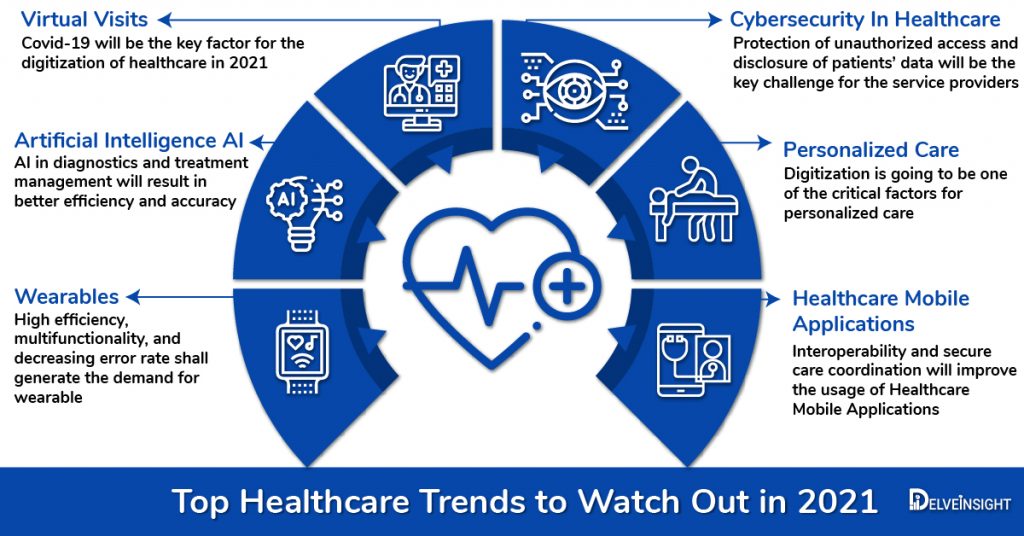Healthcare in 2021: Top Disruptions Bound To Impact The Way Healthcare Is Delivered
Feb 17, 2021
Table of Contents
Over the past few years, the healthcare sector has evolved significantly. Almost all the aspects of the healthcare sector, such as service delivery, communications, operation, medical equipment, and drug development, have grown remarkably and improved the overall health outcome. Technology has played a crucial role in changing the healthcare delivery system. Apart from increasing healthcare access, it has reduced the cost of care and time of healthcare services delivery. To fulfill the patient’s evolving needs and to provide them with better services, companies worldwide are focusing on delivering new applications and products to the users.
Some of the key technological changes that are likely to reshape the healthcare system in 2021 includes:
Downloads
Article in PDF
Recent Articles
- CDC study reveals; Jevtana receives yes; Herantis secures; Immuno-oncology is not cost-effective
- Ways IoT Has Transformed The Pulse Of Healthcare, And Will Continue To Do So In The Future
- World Health Day
- Social Determinants of Health Goes Beyond Just Healthcare
- Top healthcare innovations changing the healthcare dynamics
Artificial Intelligence (AI) in Healthcare
AI is one of the fastest-growing sectors, which is rapidly making its way into the healthcare industry. Improvement in the diagnostics, management of chronic conditions, drug and device development, are some of the key applications of AI. Besides it is in use to analyze population health trends, medical records, virtual nursing assistants, and administrative work. The use is limited to advanced hospitals and research facilities and in some developed countries.
During the past few years, many successful collaborations have been observed between Artificial intelligence (AI) vendors and healthcare service providers at the global level. In the coming years also the AI sector is expected to bring significant investment and collaboration. Zebra Medical Vision, Buoy Health, Enlitic, Freenome, BioXcel Therapeutics, BERG Health are some of the key companies in the AI healthcare domain, exploring and developing AI applications for cancer diagnosis, symptom checking, biopharmaceutical development, and rare disease treatment.
Healthcare Wearables Devices
With each passing day, wearable technology is in significant demand among fitness enthusiasts. The wearables collect and analyze users’ real-time medical data, which is more comfortable for physicians and doctors to examine. Depending upon the size, type, and application, the wearable collects vital health information related to heart rate, sleep movement, steps taken, calories burned, breathing, and many others. Smart Hearing Aids, Wearable Rings, SmartSleep Wearable, BioPatch, Smart Glasses, Smart Band, Smart Watches are trending wearable devices. The sedentary and unhealthy lifestyles, rising prevalence of CVD, lower cost of devices are likely to generate the demand for wearable devices in 2021 and the coming years. Key companies in the segment, such as Medtronic, Xiaomi, Huawei, Garmin, and Fitbit, offer many new devices to the user to dominate the evolving wearable market.

Personalized Care
The most important aspect of digitization is the opportunities for personalized care. Today, we are using many wearable devices, mobile applications, and smartphones that continuously collect vital stats from our bodies and provide a whole new perspective about health. The collected data and the genomic studies can play a crucial role in monitoring the symptoms and predicting potential diseases.
Cybersecurity in Healthcare
The safety of patients’ data is always a vital issue in the healthcare industry. Over the past few years, there have been many cases where the patients’ personal and medical data is compromised, which affected the patients financially and emotionally. In some cases, it can be severe enough to cost patients’ lives. Thus, it becomes essential to address cybersecurity issues in today’s connected world to maintain patient trust and safety. Companies and healthcare providers need to invest in cybersecurity and similarly need to train the staff. The government also needs to bring strict and standard legislation and regulations to deal with data breaches in healthcare and other sectors.
Healthcare Mobile Apps (Medical mobile applications)
Medical mobile applications are becoming increasingly important day-by-day. Apart from tracking the health of the persons, the mobile application is in use to issue vital health information to the user, provide patient care outside hospital and clinic, track the availability of medicine, diagnostic reports, online counseling, connecting doctor and patients, and many others. The Mobile Applications play a pivotal role in monitoring Covid-19 cases and dispensing necessary information to the general public. The mobile application has simplified many health processes that otherwise may involve human interference and resources. With better UI, functionality, accessibility, and awareness, the demand for apps is likely to get increased in the coming years.
Virtual Visits – Digitization of Healthcare
In 2020, the Covid-19 has brought a digital revolution and accelerated the demand for virtual healthcare applications such as telemedicine and telehealth. To mitigate the transmission of Covid-19, the government and health authorities also emphasized the use of electronic information and telecommunications technologies.
Besides healthcare service delivery, telehealth provides an avenue for other services such as provider and patient education, training, administrative meetings, and many others. Telehealth offers opportunities to save time and expenses. Advancements in technology, awareness among the general public, and improvement in payment structures will scale up telemedicine. However, digital literacy, connectivity, security, and patients’ healthcare records will be significant barriers to large-scale digital healthcare adoption.
In 2020, the Covid-19 pandemic brought unprecedented challenges to the healthcare system. The pandemic has impacted the global economy, resulting in a slow growth rate across various sectors, including healthcare. As the economies are opening up slowly, the industries are expected to pick up the growth and embrace the new policies and technologies. In the coming years, the healthcare industry is expected to evolve and grow significantly. Apart from the above-mentioned trend, autonomous robots in hospitals, digital therapeutics, IoT, and Big Data are emerging technologies that are expected to make a significant contribution to the healthcare delivery system.
Downloads
Article in PDF
Recent Articles
- Sjogren’s syndrome- Autoimmune Attack on Salivary and Tear Glands
- Myelodysplastic Syndromes (MDS): Key Pharma Players Unveiling Updated Findings at ASH 2021
- Japan is transforming its Healthcare sector through Regenerative Medicine
- Fake News In The Healthcare Sector: A Misinformation Crisis In The Era Of Digitalization
- World Health Day



